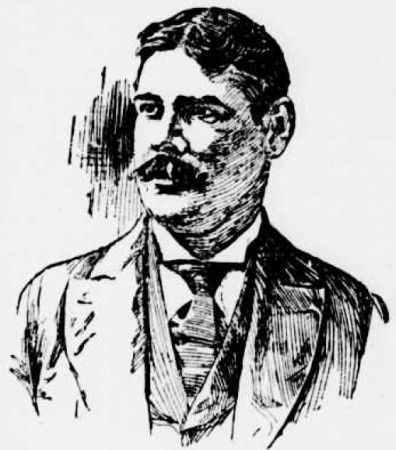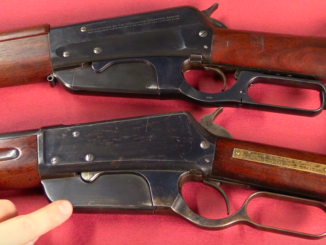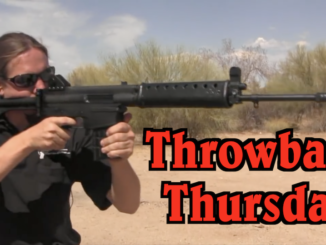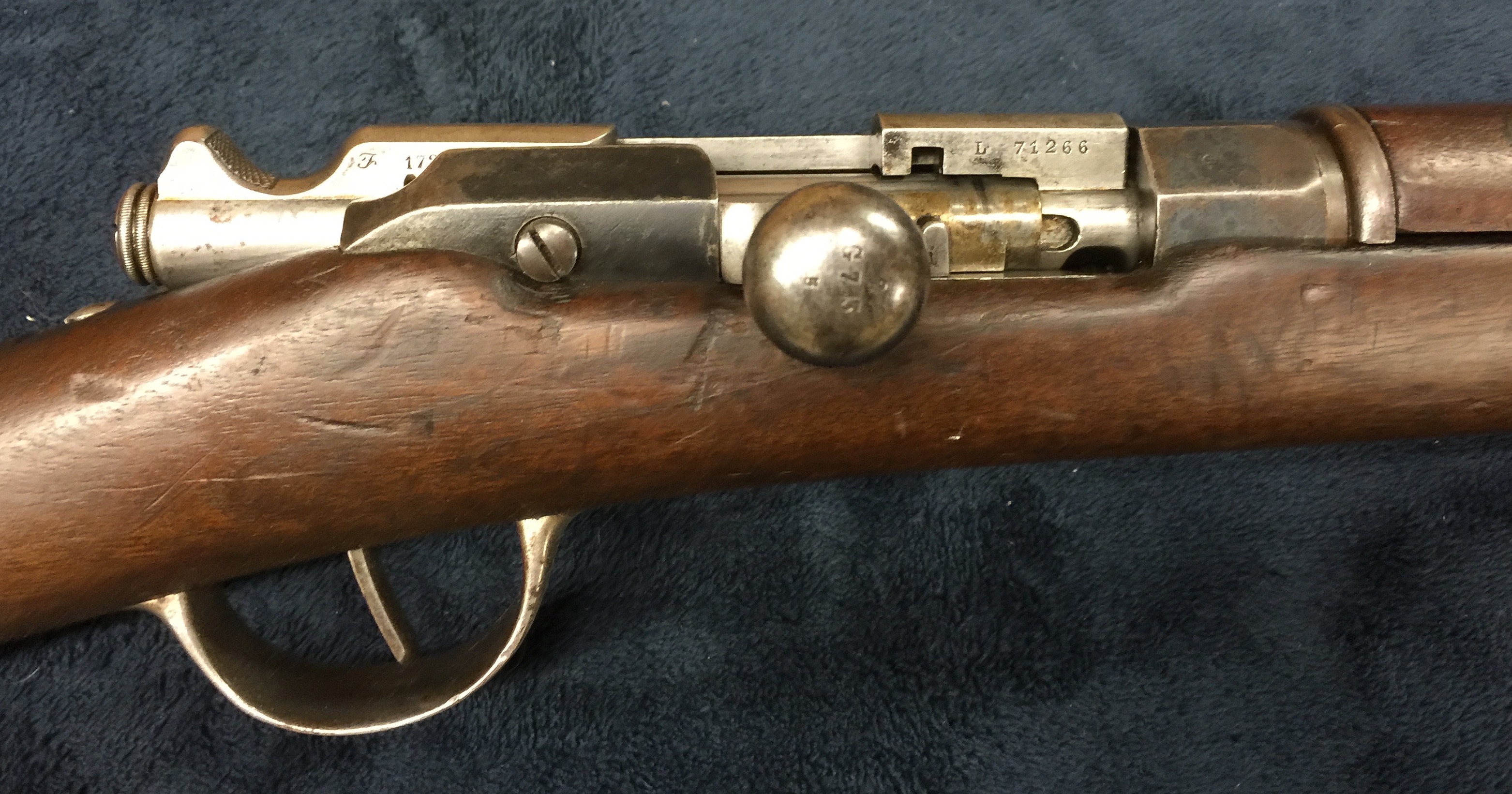
The Savage Arms Company is known today for its bolt-action rifles (which offer a particularly good value for the money; I am very fond of my own Model 10), but the company got its start and because a major firm with the success of two other guns. These were the Model 99 lever action rifle and the Model 1907 (and subsequent variations) automatic pistol. Interestingly, only one of those guns was designed by the company’s founder – he had sold his interest in the company by the time the pistol was being produced. Arthur W. Savage was not one to linger in a place or with a task – he was always being drawn to new challenges and opportunities.
Savage’s much-traveled life began in Kingston (Jamaica), where he was born on May 13th, 1857 to John and Jane Savage. His father was a devoutly religious schoolteacher there in Jamaica, although Arthur would spend nearly 15 years during his childhood without seeing him. In 1865 Jane Savage took Arthur and his siblings to visit England, and growing unrest in the then-British-colony on Jamaica prevented them from returning. His mother eventually relocated to Baltimore, but Arthur stayed in England for schooling and missionary training – not something he found particularly enjoyable. Judging from what he would go on to do, it is easy to guess that young Arthur would have found this period of time stultifying and intolerable. He was eventually able to obtain his father’s permission to rejoin his mother in 1871.
Shortly after Arthur joined her, Jane moved again, this time to Glasgow where the Savages had family. Jane died in 1873 from complications of a minor surgery, and Arthur (then 16 years of age) moved in with an uncle in London. A brief span in art school ended when he heard Charles Darwin lecture about the splendor of the natural world, and Arthur convinced his uncle to buy him passage to Australia to seek adventure.
Savage’s time in Australia began with three companions in search of gold and opals, a plan which quickly proved a failure. Savage joined up with a band of Aborigines, whom he would live with for two years, moving across the Outback. In 1876 he returned to white society, working for periods as a sheep shearer, doctor’s assistant, hotel bouncer, and cattle rancher. In the midst of this he met Annie Bryant, and the two were married in 1879 (and they would remain together until her death in 1919). Savage would stay in Australia until 1884, fathering the first four of his eventual eight children with Annie, before returning to Jamaica (by way a year’s stay in England) to manage a banana plantation. Typically for Savage, this employment kept him interested only until 1886, when he moved his family yet again to New York.
In New York, Savage took a job with Munn & Company, a publisher of patents and scientific papers. This environment seems to have unlocked a talent in Savage for inventing, because a wave of patents was to follow. The first (in 1886) was for a machine to clean hemp and other fibers, and this was followed by his first foray into firearms (possibly something that had been rattling around in his head since his days of shooting kangaroos for bounty in Australia). The British government was looking to replace the Martini-Henry with a repeating rifle, and Savage designed a .45-70 rifle with a pivoting Martini-like breechblock and tube magazine in the buttstock, which he submitted to the British trials. It failed (the bolt action Lee was chosen instead), and Savage spend several years improving the design before selling it to a company by the name of Hartley & Graham (who reportedly paid $10,000 for the patent rights, but never managed to manufacture the rifle).
As you might expect, Savage had moved yet again by this time, to the town of Utica, New York. There he took on yet another new career, this time as manager of the Belt Line Railroad. He was impressively successful at rebuilding the run-down railroad, and repeated the feat on another failing streetcar line in Saratoga Springs. Through this period he continued to tinker with inventions during his free time, making a number of improvements to early naval torpedoes and designing a new military rifle. This new design was a lever action design, and Savage invented a type of rotary magazine for it to prevent the problems inherent in using smallbore cartridges in a tube magazine (namely, a bullet detonating a primer in the magazine). Two prototypes was made (apparently by Colt) and submitted to US Army trials in 1892, where Savage was again rejected. This time the main causes were slow loading and awkwardness operating the lever action in a prone position. The Krag-Jorgensen was eventually adopted as the winning design.
Savage patented several aspects of this rifle design in 1893, and in 1894 formed the Savage Repeating Arms Company. He contracted production to Marlin, and sold his rifle to the commercial sporting market as the Model 1895. It was a handsome-looking gun, and its 5-round magazine of spitzer cartridges was an elegant improvement over single-stack magazine designs like the Winchester 1895 or tube magazine designs – and its enclosed action made it much less susceptible to dirt than other competing guns. About 5000 of these rifles were sold over the next 4 years, and Savage decided to open his own factory, and began producing the updated Model 1899 (aka Model 99). This would prove an extraordinarily long-lived rifle, with versions being manufactured into the 1980s.

Arthur Savage, however, could not be tied down to the company. In 1905 he sold his interest in the firm and moved to California and took up the orange-growing business. This, predictably, lasted on a few years, and in 1911 his interested turned instead to automobiles and he moved to San Diego and patented the radial tire. In this pursuit he formed the Savage Tire Company, which he ran until selling it in 1919. Savage continued to tinker with guns during this time, and in 1917 formed a new gun company in partnership with his son Arthur J, although the company was unsuccessful. Savage would go on to involve himself in oil drilling, gold mining, pipe, brick, and tile manufacture, ceramics, and to manage the San Gabriel Water Company for a time. His string of new adventures would come to an end in 1938, when he found himself diagnosed with a painful and terminal form of cancer. Arthur Savage was not a man to he held down, and the prospect of a slow and lingering death must have been utterly abhorrent to him. As was his nature, he took dramatic action and ended his own life on September 22, 1938 with a single shot from a pistol. He was 83 years of age.
After his departure in 1905, the Savage Arms Company would go on to produce a massively successful .32ACP pistol, to be a principle supplier of military arms during both World Wars, and to produce a well-respected line of firearms to this very day. To think that this legacy comes from just one of so many of Arthur Savage’s passing endeavors certainly leaves one in admiration of the man’s talents.
Bibliography
Brower, Bailey Jr. Savage Pistols. Stackpole Books, Mechanicsburg PA, 2008.




It sounds as if he were a colorful and multi-talented gentleman who enjoyed a life well-lived.
The production Savage Model 1895 had a 5 round magazine, like the 1899, not a 9 round magazine. Tere were higher capacity prototypes made, but I don’t think they were even submitted for military trials.
The primary improvement of the Model 1899 was an arc shaped locking surface at the back of the breech bolt. The Model 1895’s flat, perpendicular locking surface resulted in receiver cracks at the edges of the breech bolt locking surface.
Great post, thanks. When I decided that I wanted to add a Lee-Enfield to my collection, there was only one model I had in mind, a Savage-made (“square S”) Lend-Lease No. 4 Mk I*. This colorful history only adds to my pleasure in owning such a rifle. Cheers, Matthew
and causes me to miss mine! I guess I’ll need a model 99 to replace it.
Good reading; the man was truly exceptional and should we say, hardly consistent in his endeavours. Here is article on one somehow ‘forgotten weapon’ which has been attached to name Savage, although it is another man’s work: http://www.thetruthaboutguns.com/2013/10/jeremy-s/obscure-object-desire-savage-1907-45-pistol/
I did not check if Ian was doing a piece on it in past; maybe he did. Regarding .32 version, I believe that was straight blowback, not related to model 1907. But, whatever the past was the Savage name is seriously cast in history of firearms and for good reason: they make good stuff.
Hi Denny – not only did I do a bit of an article on it, I managed to shoot one too. 🙂 They are both similar systems, using a rotating barrel.
Oh yeaah, it is as you say. I rally like these pistols – I consider myself rotating barrel pistol aficionado… ))).
http://www.youtube.com/watch?v=Eyq4mMwY8n8
It is too bad that Savage dropped the 99 several years ago; read an interview that the company was willing to make it again, but none of the staff engineers wanted to try to figure out how to make it in an affordable manner using modern machinery. At least they aren’t turning out junk to capitalize on their legacy.
Jacob –
The magazine spool (rotor) in the Model 99 is caliber specific and very tricky to manufacture. Savage lost and/or damaged the spool tooling and gauging during their long, bitter 1988 bankruptcy and no one has figured out how to make the spools again. A reformed Savage Arms made 1,000 Model 99’s in the 1990’s from Spanish investment castings, but they had to use box magazines due to the spool issue. American shooters were never very enthusiastic about the box magazine Model 99s and the ‘Spanish’ Model 99s did not sell well.
Fascinating. In my youth, the 99 was the Cadillac lever gun; an average deer hunter might tote a Winchester 94 (a Browning design with absolutely nothing wrong with it, unless you wanted a scope) but a gun snob would have a 99. The same fellow would have an Auto-5 as his upland gun when the average joe got by with an Ithaca 37 or Winchester 1200.
The 99 was made in very many calibers. I did not know the spool was caliber specific but thinking about the way the gun works, it’s clear it must be.
Additive manufacturing might show the way to make the spools again. They’re relatively easily reverse-engineered into a 3D file using a coordinate measuring machine. (Or “3D scanner as the kids call it!). Then you can print the part in wax or PLA plastic, as a sacrificial pattern. Depending on how you remove the wax or PLA you can recycle it, burning it out of a plaster/sand mold, then casting the part.
Of course with Selective Laser Sintering you can make it directly in metal, stainless steel or titanium even. SLS is very expensive now but the controlling patents run out in 2014. There is a stigma on sintered parts in firearms (or there was, at one time) thanks to sintered pot-metal junk like Titan Tiger revolvers.
The additive type process is good for prototyping, short runs, and bespoke parts. It can also be used to make parts that are literally impossible with casting or subtractive processes.
One wonders what Browning, Savage, etc. is even now sketching the ideas our grandkids will take to the field.
I’ve got video of model 99 right here: http://www.youtube.com/watch?v=PKXn-x1GEHE
A gorgeous gun. At that time Europe did not have anything like this. We are talking before end of 19.century, gentlemen!
Ian –
Left handers like you and me really like the Savage 10/110 rifle and kept it alive through Savage Arm’s financial turmoil. No other company offered left handers such a good quality, accurate, and economical rifle. Right handers turned up their nose at the Model 110 due to its very manufacturing friendly design, but then no one ever forced right handers to shoot left handed guns, did they?
Have you considered a small biographical piece on Nicholas L. Brewer, the designer of the Model 110? He designed the rifle after leaving Savage in 1956 for medical reasons. He was struggling with terminal cancer in Florida when he executed the Model 110 design at the request of Savage Arms. I was told he died on the very day the first production Model 110 was assembled. He stayed on the Model 110 design and its tooling no matter how sick he was until the manufacturing line was up and running. Great story of a gifted design and manufacturing engineer who just would not give up.
I’d like to read that story, John D.
Great story; respect for the man!
A terrific, but also poignant and moving story of individual courage and determination. Thank you for sharing it — perhaps you could write a full article about Nicholas Brewer for FW if Ian would approve it?
Thank you for the information sir. Fascinating man. Just as an aside, I have always though the Savage 99 was the most esthetically pleasing American sporting rifle ever designed….
Ian – what a great story! I have this weird fascination with Australian history – might have something to do with the Aussie deeps who were studying American torpedoes in the late 70s, might have been something about a shelia from the outback I dated at decade later. But I had no idea the man responsible for my two favorite rifles had spent time on Walkabout.
Hands down, the best long-range rifle I’ve ever owned was a mid-70s Savage 99A in 250-3000 with a (looking back) ginormous straight-leg butt stock, a tang top safety, and a Schnabel front end. The .250 Savage is an incredible round – parent of the .22-250 – that only seems like a .243 Winchester until you plug a buck at three or four hundred yards. At which point you realize you have a .25-06 in a really handy lever-action carbine. I’ve never played with a .250 Savage bolt-action with a long bull barrel, but I would bet it is a monster. I had a 4X Redfield Widefield (looked like a widescreen TV, decades before they were introduced) on my 99A. Ummmm…. don’t want to brag about my 99A in .250, but it would do anything a Garand or Springfield in .25-06 would do.
When I bought my 99A I glanced over at the used-gun rack and – since every recently frocked Third Class Petty Officer needs not one but two Schnabel-forend quarter-inch rifles – I wound up with a Savage Sporter bolt job in .25-20. Hands down, the coolest centerfire rifle I have ever owned, and geeeez.. if Ian is looking for something fun and obsolete to review: the Savage 23 Sporter in .25-20 or .32-20. Lord, that .25-20 was fun, back when .25-20 ammo was cheap. I was stationed in (heavily populated) Connecticut in the 70s and both my .250 99A and my Mini-14 drew a lot of attention. But a .25-20 will do everything at 125 yards that a .22 will at 50 without making unpleasant noises. It’s a great subsonic round for (encroaching) suburbia. The Model 23 .25-20 is of historic significance in that it is the only firearm in history that did not quadrupile in value a few years after I got rid of mine. Model 23s in the Winchester 92 calibers are so uncool they are cheap. Don’t lose the magazine; replacement mags are expensive.
Your 1970’s Savage Model 99A was the only Savage in .250-3000 (including the Model 1920 bolt gun) with a factory 10 inch rifling twist. All the other Savage guns in .250-3000 had 14 inch twists and would not shoot spitzers heavier than 87 grains or round nose bullets heavier than 100 grains. This was likely the reason that the .250-3000 did not achieve wider popularity.
What an impressed story. It seems, Mr. Savage also
knew which person to match, like Mr.Searle and work
with.
Savage 1907, according to me, is one of the most
brilliant pistol designs of all time, but suffered
the lack of sufficient hesitating time due to the
very short rotating arc which partially wasted through
the affected dismount motion for breechbolt being of
the same direction. However, Frenchs corrected the issue
in their MAB P15 pistol as seeing the concept at their
purchases of big quantity.
Big designers of the past shows that,we all are eating
the same meals cooked hundred years ago.
You are right; French managed to do the ‘trick d’ jour’. As opposed to Searle they force barrel to rotate opposite, that is contrary to its natural counter-rifling tendency; thus the delay is obtained. The final balance was obtained by tuning-up the cam angle (appears to be less that on Searle’s design).
http://en.wikipedia.org/wiki/MAB_PA-15_pistol
This is reportedly very accurate pistol and that makes in connection with concept sense.
The concurrent vs. current sense of barrel rotation does not seem to play a significant role when comes to recoil/ rotation based pistols such as Beretta, CZ or Obregon.
Have you seen this eBook about that links the Savage pistol and Bat Materson (mentioned in a a prior post):
http://www.thetruthaboutguns.com/2013/10/robert-farago/ttag-exclusive-gunfighter-bat-mastersons-the-tenderfoots-turn/
Hi, Denny,
Glad to read your comments. However, Mr, Searle
forced to develop such a design, most probably,
not interfere to Mr.Browning’s patent rights which
contained the recoil/rotation construction, same as
with the unitary slide. But, in fact, Searle’s way
needed much more brain effort than straightforward
recoil version. In reality, the system, possibly
got used the Blish “Static Friction” approach which
patented thereafter, since the two different kinds
of metal, steel and bronze sticking each other under
highest level of gas pressure, during obturation,not
between the case and chamber wall, but also between
the case bottom and breechblock face as sustaining
the barrel rotation. Mr Searle did not state that
situation in his patents, but the construction got
used of it.
What an incredible life story of a multi-talented and innovative man! One of the aspects of his life that caught my eye ( all of them did, how could one not help it with such a personality? ) was the time he spent in Australia with the Aborigines. That time he spent in the bush on “Walkabout” may have had a profound influence on the rest of his life and his subsequent endeavours — perhaps I am a little biased as my parents live in Western Australia and have a profound sense of history of the continent.
Anyway, Savage’s restlessness and worldliness, all rolled into one, along with his diverse talents, bring to mind the term “Renaissance Man” in a way far closer to the real gist of that term than most conventional academic interpretations would.
As far as inventions ( including firearms ) go, nothing made by the hand of Man is viable without the mind and workmanship of the Man himself behind it, plain and simple. It is equally important that this continuity be engendered through the generations and not subjugated to the whims of shareholders ( who frequently understand little but their personal money-driven agendas ) and the God-almighty dollar. I am so thankful that Savage, like Weatherby and a few others, have not given in to the temptations of Wall Street and everything associated with that den of inequity.
Savage guns are still among some of the best-made of their kind, as so many FW contributors have attested. I have a few Savage rifles in my inventory, including the supposedly low-end, baseline Savage Axis bolt-action rifle in .243 Winchester. It will still out-shoot and out-perform many much more expensive “superior” rifles, and I have subjected it to some truly trying field conditions that it has shrugged off which have effectively stymied those same other rifles — the benefits of owning a cheap rifle that you can afford not to care about as much, but which, conversely, proves over time, that the underdog may actually be superior to the supposedly “better” guns.
What’s interesting is that the Savage Axis is gradually winning over more and more converts to it’s virtues and adaptability, all at a cost-effective price point. More and more after-market manufacturers also seem to be waking up to this realization as of late.
The Axis might not be the ultimate bolt-action sporting rifle by any means, but it is definitely a versatile, functional, practical, and thoroughly workman-like rifle that does what it was designed for very well, and then some. The higher-end Savage rifles are more of the same, except that they come a lot closer to fulfilling that “ultimate” quality goal. A little like Mr.Savage and his legacy.
Well done,
I also own two of those, good quality for the price…except that over here in Italy, they cost nearly
double…
Ciao
Normann
I inherited my uncle’s rifle 5 yrs ago and was told by my father it was my uncle’s service weapon while in the korean war. i have found it hard to research this rifle it is a savage high pressure steel,250-3000 bolt action, rifle, with brown leather strap. I plan to pass this down to younger generation of children. but would like more info on this rifle and what size ammo does it use
Very difficult to get a real history on Arthur savage and the developement of the mod.
95 ( the two window type) all articles seem to very somewhat. I happen to have a four
digit original mod. 95 ( all matching serial numbers including wood stock) with Marlin
proof marks under the octagonal barrel just ahead of the receiver. Of course chambered
in 303 savage and every once in awhile still shoot it. Have read some of the comments
regarding the square bolt and cracking to the top rear of the receiver, there is no evedence of this on this 95 despite the fact that it was used to hunt with until mid 1970s
by a great uncle. This rifle has a 22″ barrel and does not have a German silver blade
front sight. I’m 67 years old and never thought to ask the old uncle, who died in 1979
in his mid 80s, about any of the particulars. This rifle does not look altered and has been
in one family for three generations. Would appreciate any comments.
Excellent story on a genius in our firearm world. I’ve a good number of these fine rifles the newest being a 1951 year of mfg in the famous 300 cal back to a 1904 1899c in 38/55 . Even managed to pick up the takedown models and three saddle ring carbines , now I’m bragging but you know what ? I don’t care , I’m proud of these fine rifles. Have a fine day !
Steve
Excellent story on a genius in our firearm world. I’ve a good number of these fine rifles the newest being a 1951 year of mfg in the famous 300 cal back to a 1904 1899c in 38/55 . Even managed to pick up the takedown models and three saddle ring carbines , now I’m bragging but you know what ? I don’t care , I’m proud of these fine rifles. Have a fine day !
Steve